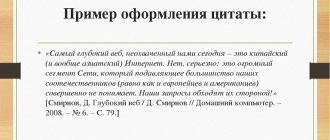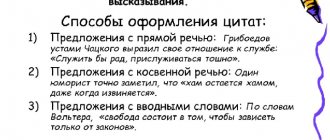§ 54. Quotation marks
§ 54.1
Quotations are enclosed in quotation marks. If the quotation is formatted as direct speech, that is, accompanied by the words of the author citing it, then the appropriate punctuation rules apply (see § 47 - 50):
Belinsky wrote: “Nature creates man, but society develops and forms him”;
“Twelve million people are outlaws!.. Horror!” - A. I. Herzen wrote in his diary, referring to the serfs in Russia at that time;
“The primary element of literature, ” M. Gorky pointed out, “ is language, its main instrument and, together with the facts and phenomena of life , the material of literature”;
The speaker cited the words of M.V. Lomonosov: “Russia’s power will increase through Siberia” - and with this he ended his speech.
↑ Contents ↑
§ 54.2
If the text continues after a poetic quotation, then a dash is placed at the end of the poetic line: Tatyana’s husband, so beautifully and so fully characterized from head to toe by the poet with these two verses:
...And above everyone
And he raised his nose and shoulders
The general who came in with her,
Tatiana's husband introduces Onegin to her as his relative and friend (Bel.) - the words Tatiana's husband are repeated in order to connect the second part of the author's words with the first part (cf. § 40, paragraph 2).
↑ Contents ↑
§ 54.3
If the quotation consists of several paragraphs, then quotation marks are placed only at the beginning and at the end of the entire text:
In the article “From the history of Russian literature” M. Gorky wrote:
“What makes literature so powerful?
Saturating ideas with flesh and blood, it gives them greater clarity, greater persuasiveness than philosophy or science.”
Often, to more clearly indicate the boundaries of a quotation, especially if there are also quotation marks inside it, an additional special printing method of highlighting the quotation is used (typing in a smaller format, typing in a different font, etc.).
↑ Contents ↑
§ 54.4
If, when giving a quotation, the author or editor (publisher) underlines certain words in it (such places are highlighted in a special font), then this is specified in a note enclosed in brackets, indicating the initials of the author or the abbreviation Ed., preceded by a dot and a dash: (emphasis added by us. - A.B.), (italics ours. - A.B.), (discharge ours. - Ed. ). Such a note is placed either immediately after the corresponding place in the quotation, or at the end of a sentence or quotation as a whole, or as a footnote (in the latter case, the note is given without parentheses).
↑ Contents ↑
§ 54.5
If the author or editor inserts his own text into the quotation, explaining the sentence or individual words of the quotation, then this text is placed in straight or angular brackets; the author's initials, as well as the word Ed. in this case do not put: N. S. Shchukin recalled A.P. Chekhov: “To become a real writer,” he taught <A.P. Chekhov>, “we must devote ourselves exclusively to this matter.”
↑ Contents ↑
How to properly quote anti-plagiarism in Word?
When typing a thesis or term paper in Microsoft Word, use ordinary quotation marks to indicate citations. Don't wrap them around anything other than the quoted portion of the document.
. Each quote is formatted in this way, even if they come one after the other. Forget about additional formatting and the use of any service or invisible characters - ordinary quotes are enough.
Now you know how to make sure that anti-plagiarism sees the citation - just mark the quotation with quotation marks
. It is the quotation marks that give the anti-plagiarism signal that this section may be a citation. Despite the presence of quotation marks, this section continues to participate in the test. But when generating the final results, it can be omitted.
Why "may"? The thing is that the presence of quotation marks is not an absolute indicator. They are a marker of the quoted text. If anti-plagiarism truly considers the highlighted section to be a quotation, then it will not affect the uniqueness of the work. If you mark in quotation marks any other section of the text that is not a quotation, anti-plagiarism will not react to this selection in any way - wrapping it in quotation marks does not exclude the section from the check for uniqueness.
§ 55. Ellipsis when quoting
§ 55.1
If the quotation is not given in full, then the omission is indicated by an ellipsis, which is placed:
1) before the quotation (after the opening quotation marks), which is not syntactically related to the author’s text, to indicate that the quotation is not given from the beginning of the sentence: L. N. Tolstoy wrote: “... in art, simplicity, brevity and clarity are the highest perfection of the art form” ;
2) in the middle of the quotation, when part of the text inside it is missing: Speaking about the merits of the language of folk poetry, A. A. Fadeev recalled: “It is no coincidence that our Russian classics... recommended reading fairy tales, listening to folk speech, studying proverbs, reading writers who possess all the richness of Russian speech";
3) after the quotation (before the closing quotation marks), when the quoted sentence is not fully quoted: Speaking in defense of the culture of oral speech, A.P. Chekhov wrote: “In essence, for an intelligent person to speak badly should be considered the same indecency as not be able to read and write..."
↑ Contents ↑
§ 55.2
After a quotation ending with an ellipsis, a period if the quotation is not an independent sentence: M.V. Lomonosov wrote that “the beauty, splendor, strength and richness of the Russian language is evident from books written in past centuries...”.
If a quotation ending with an ellipsis is an independent sentence, then a period is not placed after the quotation marks (as in direct speech; see § 47, paragraph 5): V. G. Belinsky wrote: “In Onegin, all parts are organically articulated... »
↑ Contents ↑
Why doesn't anti-plagiarism see citations?
There are cases when anti-plagiarism does not see citations. We mark the quote with quotation marks, and the output is text with a low uniqueness score. To understand why anti-plagiarism does not see citations, let’s return to the terminology. A quotation is a verbatim excerpt from a document or source. The anti-plagiarism quote is an excerpt from:
- Scientific work;
- Published educational publication;
- Collection of laws and regulations;
- Periodicals.
How does anti-plagiarism recognize citations? It's simple - it uses material libraries connected by developers to recognize databases. Some materials are included and some are not. That is why half of the citations in the work are counted, and the other half are not.
Why is citation not displayed in anti-plagiarism? If so, the source of the quotation is not included in the list of materials used. Sometimes excerpts from well-known magazines, scientific publications and textbooks are not recognized as quotations. Why they are not included in the sources of citations is unknown.
Anti-plagiarism also uses a database of already written works - abstracts, diplomas and coursework - to check the uniqueness. And if you take an excerpt from someone else’s thesis as a quotation, it will not be counted as a quotation. If you want to use part of someone else's work, work on it and make it unique, or use our automatic uniqueness enhancement service. Otherwise, the uniqueness will be low - even if you put text fragments in quotation marks.
§ 56. Punctuation marks when referring to the author and the source of the quotation
§ 56.1
If an indication of the author or source of a quotation follows immediately after it, then it is placed in brackets, and the period after the quotation is omitted and placed after the closing bracket: “The significance of Belinsky in the history of Russian social thought is enormous” (Lunacharsky).
↑ Contents ↑
§ 56.2
The title of the work following the author's surname after the quotation is separated by a period and is not enclosed in quotation marks; a dot separates the output data: “You must be able to use words that would most accurately and most subtly express the thoughts that concern the artist” (Fadeev A.A. Literature and Life. M., 1939. P.155).
The first word indicating the source of the quotation is written with lowercase letter, if it is not a proper name: The approach of a thunderstorm is artistically described as follows: “Lightning flashed between the distance and the right horizon, and so brightly that it illuminated part of the steppe and the place where the clear sky bordered on blackness. The terrible cloud was approaching slowly, in a continuous mass; large black rags hung on its edge; exactly the same rags, crushing each other, piled up on the right and left horizons” (from the story “The Steppe” by A.P. Chekhov).
↑ Contents ↑
§ 56.3
If an indication of the author or source of a quotation is not given directly after it, but is placed below, then after the quotation a dot (or other sign appearing in the source) is placed:
How can you not love your native Moscow?
Baratynsky
Epigraphs are usually written without quotation marks, and a link to the source is given without parentheses; Wed epigraph to the fifth chapter of “Eugene Onegin”:
Oh, don’t know these terrible dreams, you, my Svetlana!
Zhukovsky
↑ Contents ↑
How to turn borrowing into citation for anti-plagiarism?
Borrowing is copying fragments of text from other works. You won't be able to mark it as a citation. The thing is that anti-plagiarism uses millions of sources to recognize citations. A quotation from the Criminal Code of the Russian Federation or a scientific work is a quotation. Text copied from somewhere and surrounded by quotation marks is not a quotation. The same applies to borrowing. To make a site unique, you need to rewrite it in your own words. Or just use our uniqueness enhancement service for 100 rubles and 2 minutes.
§ 57. Uppercase and lowercase letters in quotations
§ 57.1
If the quotation is syntactically connected with the author’s text, forming the subordinate part of a complex sentence, then the first word of the quotation is written, as a rule, with a lowercase letter: Speaking about Pushkin’s poetry, N. A. Dobrolyubov wrote that “in his poems, for the first time, living Russian speech was revealed to us , for the first time the real Russian world was revealed to us.”
↑ Contents ↑
§ 57.2
with a lowercase letter and in the case when it, being syntactically unrelated to the previous author’s words, is not given from the beginning of the sentence, that is, it has an ellipsis in front of it: D. I. Pisarev pointed out: “... the beauty of language lies solely in its clarity and expressiveness.”
↑ Contents ↑
What does citation mean in anti-plagiarism?
First, let's figure out what a quote is and why it affects the uniqueness of the work.
A quotation is a verbatim excerpt from a text, document, or statement.
. For example, from a textbook or from the scientific work of a famous scientist. The use of quotes in texts does not require the consent of the author, but requires an indication of the authorship and the source of borrowing - in accordance with the rules for designing works. The passage is included in the text without changes - verbatim and without distortion.
The student’s task is to ensure that the quotation does not affect the uniqueness of the thesis or course work. Anti-plagiarism, analyzing the work, compares individual sections with millions of sources - these are tens of thousands of textbooks, libraries of scientific works, other abstracts and works, libraries of periodicals, legislative frameworks and databases of regulatory legal acts, databases of articles and publications. The presence of text copied verbatim from these sources in a work is a reason to reduce uniqueness. But writing dissertations and term papers is simply unthinkable without the use of citations.
How to format a citation so that anti-plagiarism shows the citation and does not count it when calculating the percentage of uniqueness? You cannot simply take and copy the text from the source directly - the results will be disappointing, and the work will have to be resubmitted. But you cannot rewrite the quoted sections in your own words - they will lose the status of quotations. And knowing the capabilities of the anti-plagiarism system, we can assume that it will count this approach as a rewrite - anti-plagiarism easily recognizes modified sections.









